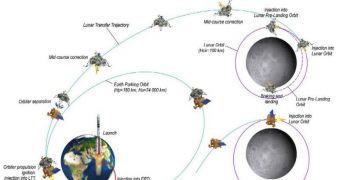Officials at the Indian Space Research Organization (ISRO) finally announced the instruments and tool suites that will go aboard its next lunar mission, called the Chandrayaan-2.
For the past few years, India has been playing an increasingly important role in space exploration, developing a number of missions alongside other space agencies, or on its own.
One of the most important missions that the ISRO developed was the Chandrayaan-1 orbiter, which managed to achieve lunar orbit, and conduct observations from its vantage point.
The mission eventually ended in failure, after contact with the orbiter was lost, but to the Indians this was a monumental achievement. Now, they want to continue in the footsteps of the first mission.
The Chandrayaan-2 is a more complex plan, which calls for the construction of both a rover and a lander, all of which are to be finished by 2013.
ISRO officials said yesterday that they expect the mission to launch from the Satish Dhawan Space Center, in Sriharikota, aboard an Indian-built Geosynchronous Satellite Launch Vehicle (GSLV).
The lander itself will be built by the Russian Federation, under an agreement between the two parties. At this point, only the basic instrumentation for both mission components has been approved.
Experts believe that other equipment may be selected for integration aboard the Chandrayaan-2 mission as well, but that will be decided upon in technical review that will take place further along the mission time line.
Some of the instruments and suites experts recommend for the orbiter include the Large Area Soft X-ray Spectrometer (CLASS) and the Solar X-ray monitor (XSM).
Both of these payloads are meant to give the orbiter the ability to map out the most interesting elements of the lunar surface in great detail.
Other instrument suites include an L and S band Synthetic Aperture Radar (SAR), an Imaging IR Spectrometer (IIRS), a Neutral Mass Spectrometer (ChACE-2), and a Terrain Mapping Camera-2 (TMC-2).
As far as the experts are concerned, the orbiter could include only two scientific payloads. One of them could be the Laboratory for Electro Optic Systems (LEOS)- built Laser induced Breakdown Spectroscope (LIBS).
The second one could be that Alpha Particle Induced X-ray Spectroscope (APIXS), an instrument designed and built by the Physical Research Laboratory (PRL), SpaceRef reports.

 14 DAY TRIAL //
14 DAY TRIAL //